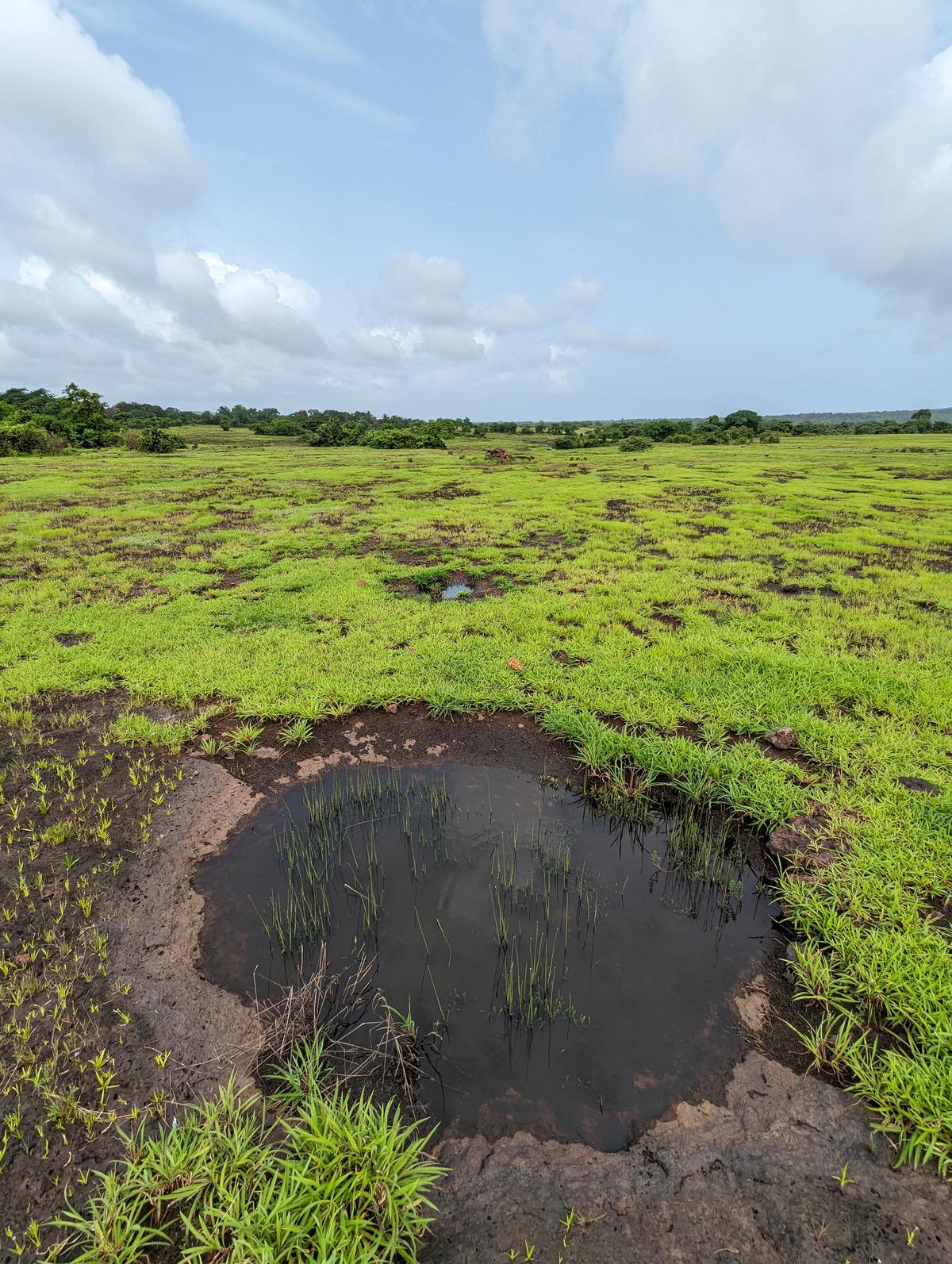Formed over millions of years ago, Maharashtra’s Konkan region’s lateritic plateaus, called ‘sadas’ in Marathi, are home to a diverse range of flora and fauna. These plateaus support unique freshwater rock pools that are formed due to erosion and weathering over a period of time and are critical frog breeding habitats.
A paper titled: ‘Effects of abiotic and biotic factors on tadpole occurrence and abundance in seasonal rock pools of rock outcrops, northern Western Ghats‘ published on a Netherlands-based journal, Aquatic Ecology on April 4, 2025, by research fellows and scientist from Nature Conservation Foundation, Vijayan Jithin and Rohit Naniwadekar, explains how the size of freshwater rock pools on the rocky outcrops, monsoon progression and presence of predators, influence the tadpoles growing in them.
Rock pools are depressions on rocky surfaces with pan – or bucket-shaped pools that are fed by monsoon rains. They harbor various endemic organisms uniquely adapted to the highly variable environment in the open rocky ecosystems. Since these depressions on the rock surface can temporarily store water during the monsoon time, they act as breeding grounds and tadpole habitats for frogs living around the area. Frogs generally need water bodies for breeding, depositing their eggs, and tadpole development.
These rock pools are also favourable to other organisms such as microscopic phytoplanktons, zooplanktons, larger algae, aquatic plants, insects, and vertebrates. Many of these are also endemic species, often occurring only in a few pools.
The lateritic rock pools can be found only along the Western coasts, starting from north Kerala till Maharashtra’s Ratnagiri district. The extensive Deccan volcanism has resulted in the greatest expanse of low-elevation lateritic plateaus of the Western Ghats, harbouring many rock pools in these open habitats.
The researchers carried out the fieldwork in Devihasol village of Rajapur taluka in Ratnagiri district from July to September 2022. The paper says that tadpoles’ survival depends on various biotic and abiotic factors in the aquatic habitat, including predation, competition, aquatic permanence, temperature, and anthropogenic disturbances, among others.
Mr. Jithin explained that for breeding, the frogs need water to last till the eggs hatch and tadpoles develop into frogs, which can last a few weeks. This is enabled by the rock pools that act as safe shelters of tadpoles due to water availability, presence of aquatic plants that provide them cover, availability of food items such as algae, and the absence of large predators like fishes makes them a perfect breeding habitat for frogs.”
This research paper is the third output from their fieldwork in Konkan during 2022. “Our earlier results from the same project that looked at how agricultural land-use change is impacting the biodiversity of the lateritic plateau have shown the importance of different microhabitats for adult amphibians, especially rock pools,” Mr. Jithin said.
Since these studies were exclusively on adult animals, the duo wanted to study the tadpoles of frogs to build a baseline understanding of the larval life of frogs in the rockpools. “Most frogs have two phases in their life histories: free-swimming tadpoles and adults. To many, the tadpole stage can be an important part of their life cycle, influencing adult populations. Despite this, most of our research usually focuses on adult frogs,” he added
Their earlier study suggested the importance of rock pool availability for adult frogs, and they recommended restoration or creation of rock pools for amphibian conservation, considering reduced fresh rock pool availability due to rapid conversion of outcrops to orchards.
Mr. Naniwadekar said that so far, no other studies have looked at the basic ecology of tadpoles in the rock pools of lateritic plateaus. Also, in the Indian tadpole ecology scenario, there is only limited information available from forested streams.
The team investigated the relative influence of rock pool size, monsoon progression, and predator abundances on the occurrence and abundance of tadpoles of three species of frogs, namely, Jaladhara Skittering Frog, Nilphamari Narrow-mouthed Frog, and Common Indian Treefrog, which were easily identifiable in the field and regularly detected in the rock pools.

A rock pool in Devihasol village of Rajapur taluka in Ratnagiri, Maharashtra.
| Photo Credit:
Vijayan Jithin
Mr. Naniwadekar said, “We expected that tadpole occurrence and abundance would be positively associated with pool size since larger pools will hold water during non-rainy days, thereby protecting tadpoles from desiccation; negatively associated with monsoon progression as the end of monsoon poses survival risks due to desiccation; and negatively associated with the abundance of potential predators.”
They monitored 10 fresh rock pools spread over 1.15 km in the low-elevation lateritic plateau area. The monthly rainfall during the study period varied from 408.1 mm in September to 639.8 mm (July) in the study area.
Mr. Jithin, who has been studying tadpoles since he was pursuing his master’s in Wildlife Science from the Wildlife Institute of India, said that they did not sample after the monsoon, as the pools do not hold water for long after the monsoon due to direct sunlight exposure. He conducted nighttime pool surveys between 7 p.m. to 10 p.m. to assess tadpole occurrence and abundance. “We counted tadpoles of the three species and their potential invertebrate predators: fishing spiders, crabs, and dragonfly larvae.”
Tadpoles of frogs contribute to biodiversity by influencing ecosystem functions like leaf litter breakdown, sediment removal, and nutrient cycling, which are critical for healthy soil, water, and food production. “They benefit humans by improving fertility for plant growth, maintaining water quality, and aquatic life. Conservation of rock pools, which are home to tadpoles and other organisms, is thus important for ecosystem maintenance, especially in the light of climate change, where erratic rain patterns and an increase in temperature are expected,” explained Mr. Jithin.
The researchers said that considering the global threats amphibians are facing from habitat degradation and land conversion, particularly agricultural land-use change in the rock outcrops, the importance of species-specific tadpole ecology studies is crucial, as they can inform species-specific conservation strategies.
Published – May 13, 2025 02:53 am IST


Leave a Comment